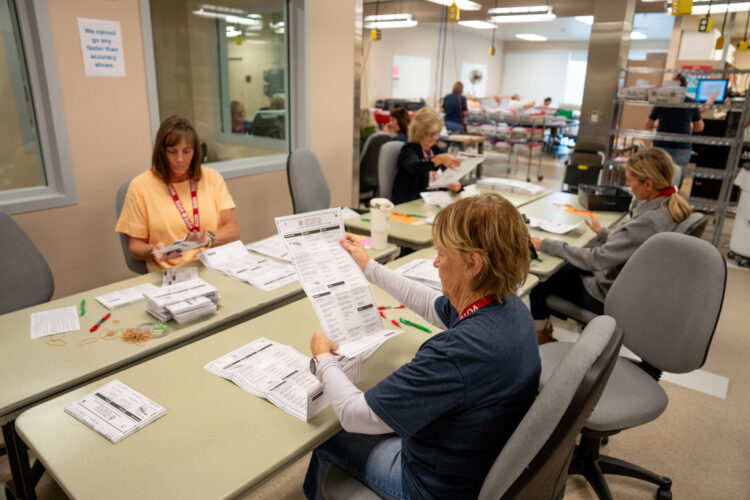How to make sure your vote counts: By-mail ballots now have tighter deadlines
Utah lawmakers have enacted restrictions to voting by mail — but most changes don’t take effect until 2026 and 2029. Here’s what you need to know ahead of Election Day on Nov. 4

Photo by Spenser Heaps for Utah News Dispatch
Election workers process ballots at the Davis County Administrative Building in Farmington on Election Day on Nov. 5, 2024.Election Day next Tuesday will mark the first general election since the 2025 Utah Legislature passed sweeping changes to the state’s election laws — but for now, only one crucial vote-by-mail deadline has changed.
Previously, county clerks have been allowed to count a by-mail ballot as long as it’s been postmarked on or before Election Day, even if it arrives at clerks’ offices days later. But now, Utah law requires ballots to be in clerks’ possession no later than 8 p.m. on election night, regardless of their postmark.
That means Utahns wanting to vote by mail now have a shorter timeframe to mail their ballots in on time — and run a higher risk of their ballots not being counted if they mail them too close to Election Day.
To be safe, county clerks are encouraging Utah voters — if they have any doubt that the post office might not deliver them on time — to instead drop their ballots at a designated drop box or directly at their county clerks’ offices on or before Election Day.
Voters can use the state’s election website or their county clerks’ websites to look up drop box locations or in-person voting locations. Salt Lake County, for example, has posted a list of Election Day vote centers that will be open from 7 a.m. to 8 p.m. where people can drop off their by-mail ballot or vote in person with a valid ID.
The moved up vote-by-mail deadline is just one of many changes included in HB300, a bill passed by Utah lawmakers earlier this year enacting a long list of changes, including more restrictions to voting by mail.
However, it’s important to note that most of the new law’s changes have a delayed effective date — with the most substantial changes not scheduled to become law until 2026 or, in some cases, until 2029.
In addition to moving up the voting-by-mail deadline, here’s a breakdown of HB300’s most important changes and when they take effect (unless lawmakers make any additional changes between now and 2029):
- Starting in 2026, voters with a valid state ID will be required to include the last four digits of their state ID or Social Security number on their by-mail ballot. However, for registered voters who cast their ballot without an ID number, clerks can still use signature verification to verify ballots — but only until 2029. That year, clerks will then be required to move away from signature verification and instead rely on ID number ballot verification.
- Utah’s current automatic vote-by-mail system will be phased out by 2029. Starting Jan. 1 of that year, in order to vote by mail, Utahns will be required to obtain a valid state ID and opt in to have a ballot mailed to them. They’ll also be required to continue to opt in every eight years.
- Beginning in 2029, voters who vote in person must present a valid ID, except in certain circumstances, in which a voter could sign an affidavit and present two forms of alternative ID (like a Social Security card, bank statement or paystub).
Confusion over four-digit requirement
Though most of HB300’s provisions won’t take effect until years later, the new law has caused some confusion — particularly in one county where a clerk decided to “test” the four-digit ID requirement early.
For the 2025 municipal primaries in August, Utah County Clerk Aaron Davidson included a space for those four digits on that county’s ballot envelopes — but he told KSLTV that he opted against doing it again for the November municipal elections after his office found some problems with that verification method.
“We identified 790 ballots where the signature did not match, but the four digits did,” Davidson told the outlet.
So for the 2025 general election next week, Davidson decided to remove the four-digit space off of the ballot envelope. However, county officials included the same instructions from the primaries instructing voters to write the four digits, even though there was no longer a space to do so.
That meant for the November election his county’s voting instructions included inaccurate information — but Davidson told ABC4 he decided against re-printing the instructions because it would have cost more taxpayer money.
“We just didn’t feel it was physically fiscally prudent to throw those instructions out and have them reprinted,” he told the TV station. “So we sent out the instructions from the primary (in the general election) and it does say to put the four digits on, but we figured we’d just address those issues with voters, as they call — (and) just let them know you can add the four digits if you want to at the end of your signature.”
It’s more likely than not that Utah lawmakers between now and 2029 will make more changes to the state’s election laws — so it’s possible the four-digit ID requirement could be tweaked or changed entirely.
But for Election Day next week, the most important thing voters need to know is that the only change enacted so far is that by-mail ballots have to be in county clerks’ hands by 8 p.m. on Election Day. There are no requirements — yet — to write four-digit ID numbers on ballot envelopes.
If you have other questions about how to vote, visit vote.utah.gov, or contact your county clerk’s office.



